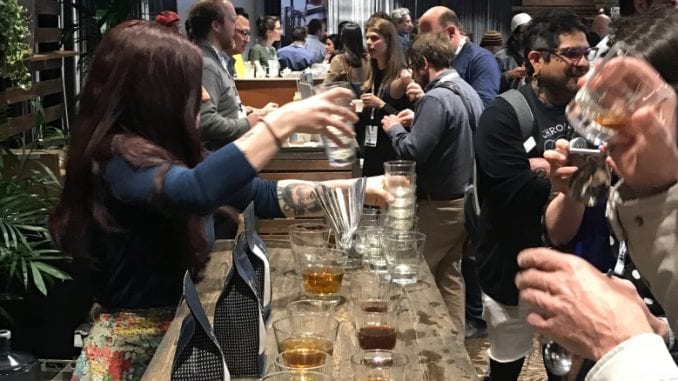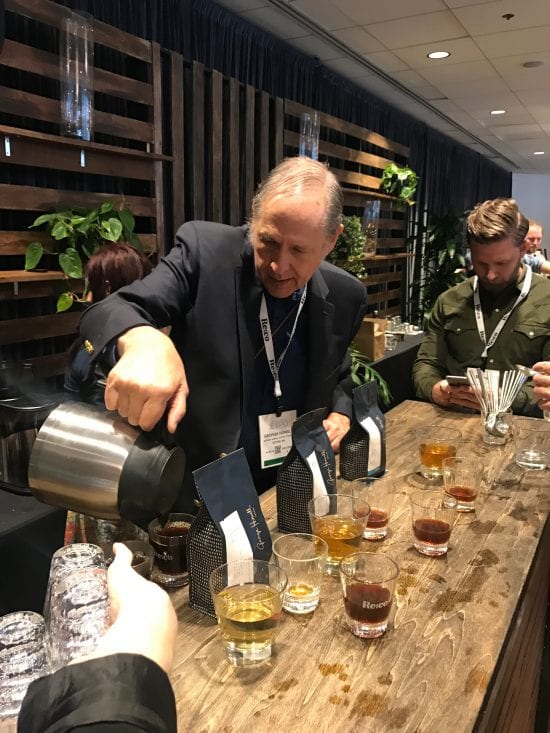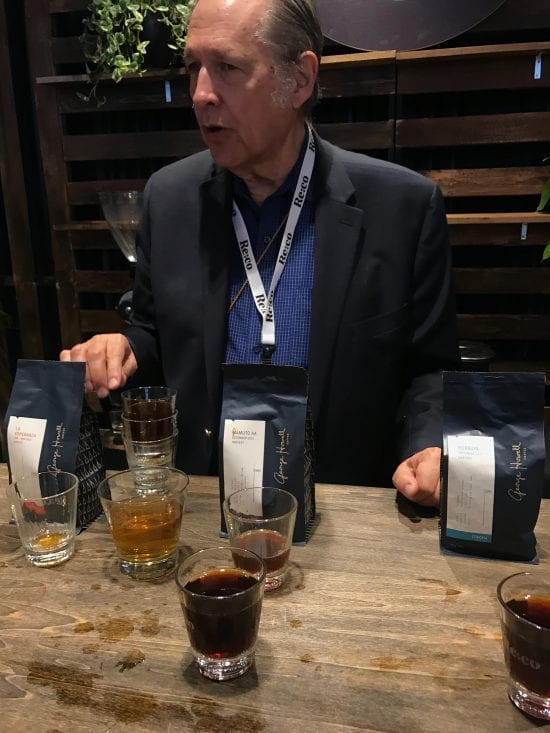
George Howell has been a known proponent of freezing green coffee, and at this year’s Re;co he unveiled a series of ‘vintage’ harvests to show how freezing coffee can preserve its integrity.
BY ASHLEY RODRIGUEZ
BARISTA MAGAZINE ONLINE
Photos by Michelle Johnson
One of the biggest enemies of coffee is age. We’re taught that from picking to roasting to brewing, as coffee ages, it loses its flavor. That’s why you probably wouldn’t expect that a cupping at Re;co this April featured coffees that were harvested in 2012 and 2013. However, this was what George Howell was showcasing in conjunction with a talk led by scientist Chris Hendon (of Water For Coffee, co-authored by Maxwell Colonna-Dashwood). “By all standards, these coffees should have been dead and buried,” George shares.
What kept these coffees fresh was that they were frozen. George has long been known to sing the virtues of freezing coffee, but for many, the tasting at Re;co was their first opportunity to try these coffees. George picked three coffees—an Ethiopia Borboya and Guatemala La Esperanza from 2012, and a Kenya Mamuto from 2013—and found that they were just as fresh and delicious in 2017 as the day they were frozen. “We freeze [coffees] immediately when we get them,” he shares. “We hold about 10-15 percent of all the coffee we get …we’re slowly building a library.”

Age can be hard to detect if you’re not an experienced taster. “Age means that the coffee is losing its sweetness,” George notes. “It’s as if you have a beautiful color photograph, and then you hang it up in the sun, and now it’s a sepia tone.” Freezing coffee when it is green helps preserve its freshness and flavor, which will fade no matter how quickly you go through it. Even though innovations like sealing coffee in hermetically sealed bags does help, age is inevitable. For small roasters, this can inhibit the amount of coffee you can buy or means that the quality of your coffee will just naturally deteriorate. Along with providing better options for roasters, freezing coffee also provides a useful tool for farmers to reference past crops and compare coffees year to year. “You can create libraries of past harvests,” George notes.

The idea of freezing coffee isn’t a new idea for George. “I started freezing coffee in 2001,” he shares, “when I was a quality consultant in Peru. They were sending several hundred samples over a period of three months, and when we compared the coffees that came the first week versus the ones that came the second week, they were already aged. We could no longer compare one batch to another.” George and his team tried a few ideas. “So first we tried vacuum-sealing the coffees in 100 gram increments,” he shares. “That did not succeed … the coffees aged more slowly but they still showed signs of age. Then someone who was working for me suggested freezing it, which we did in vacuum-sealed bags. And that’s how it got started—on a small scale.”
The technology for freezing coffee is minimal, and George is excited for innovations that are affordable and accessible for small roasters. “It’s the small roasters like us who are at the forefront of quality experience and developing quality further,” he says. Right now, a handful of roasters are looking into freezing green coffee, like Canada’s Phil & Sebastian or Passenger Coffee in Pennsylvania, and George sees this technique as an easy way to increase quality and get better coffees to a larger audience. However, freezing coffee isn’t an endgame. “What people will find is when you start to freeze coffees, you have opened a new door to quality,” he shares. “And don’t think your coffee quality issues are over. You will start to find new issues.” Through freezing, George has found other issues at origin, but by isolating these issues he can address them more concretely. “You realize larger lots are comprised of multiple lots, and the coffee you cupped with no age might not be the case throughout that lot,” he shares. “It’s something that people don’t really notice because you get a coffee and two months later it’s aging, but once you freeze it [to prevent aging], you find it out fast. We have become infinitely more sensitive to age.”

Ultimately, the goal is to improve coffee quality. “We’re trying to bring the consumer to a point where they understand quality and they demand it,” George shares. “The more we can tune their taste buds to appreciate quality coffee, the better for the farmers, and therefore better for us. That’s critical. If you’re serving aged coffee—coffee that starts out fresh and is getting aged—you are not serving that purpose. And the consumer is still left not knowing what is stale and what isn’t.” George is also hopeful that more roasters will adopt his methods. “Despite the fact that this is going to create a lot more competition for me, it’s imperative that this be practiced by more specialty roasters so we can go from there,” he says.
He’s also hopeful that people will ask more questions. “What exact temperature is ideal [for freezing]? I don’t know,” he notes. But George is willing to experiment and test his theories to find the best results, which he hopes to see more of in the coffee industry—especially regarding preconceived notions of freezing coffee. “So many roasters are saying, ‘You should never freeze roasted coffee,’ and that is a complete myth!” he says. “Our experiments, over and over, have found that freezing roasted coffee is far superior than any method [of preserving coffee].”
You can order any of George’s coffees and try for yourself (“pretty much all of our coffees have been frozen,” as he puts it) on the George Howell website.

